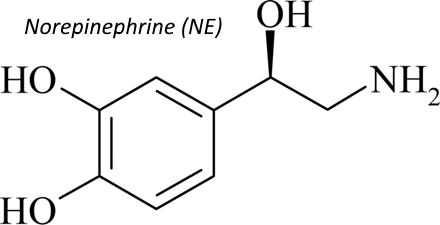Norepinephrine has numerous effects in sepsis including veno-constriction (increasing preload), arterial constriction (increasing systemic vascular resistance), positive inotropy, improved cardiac output, and improved renal perfusion. This addresses all the major derangements observed in cases of septic shock. It is important to realize that MAP doesn’t necessarily equate perfusion. Increasing the MAP with a pure vasoconstrictor like phenylephrine may not improve organ perfusion. However, if MAP is increased without causing excessive vasoconstriction (e.g. with norepinephrine) then perfusion will improve. One limitation to the use of norepinephrine is the requirement of central access due to risk of extravasation. However, several studies have now established that norepinephrine can be initiated by peripheral line for a certain period of time.
A retrospective cohort study conducted by Kelm DJ et.al. in 405 consecutive patients admitted with severe sepsis and septic shock to MICU revealed that 67% of patients developed fluid overload in day 1, and in 48%, fluid overload persisted to day 3. They also found an increase in hospital mortality associated with fluid overload in patients receiving EGDT as per current protocol.[i]
Dunser MW et.al. in a retrospective cohort study in 274 septic patients concluded that one or more episodes of MAP < 60 mmHg increased the risk of death by 2.96.[ii]
Morimatsu H. et.al studied early and exclusive use of norepinephrine in 142 septic shock patients within 24 hours of ICU admission. It showed that the restoration and maintenance of target MAP was achieved initially in all patients and, in 61.3%, within 30 min. Survival compared favorably with that predicted by illness severity scores (50% vs 74.7% predicted).[iii]
Xiawou Bi et.al. studied early versus delayed administration of norepinephrine retrospectively using data from 213 adult septic shock patients. A strong relationship between delayed initial norepinephrine administration and 28-day mortality was noted. Every 1-hour delay in norepinephrine initiation during the first 6 hours after septic shock onset was associated with a 5.3% increase in mortality. Twenty-eight day mortality rates were significantly higher when norepinephrine administration was started more than or equal to 2 hours after septic shock onset (Late-NE) compared to less than 2 hours (Early-NE). Mean arterial pressures at 1, 2, 4, and 6 hours after septic shock onset were significantly higher and serum lactate levels at 2, 4, 6, and 8 hours were significantly lower in the Early-NE than the Late-NE group. The duration of hypotension and norepinephrine administration was significantly shorter and the quantity of norepinephrine administered in a 24-hour period was significantly less for the Early-NE group compared to the Late-NE group.[iv]
A restrospective study conducted by Waechter J et.al. in 2,849 septic shock patients showed that the mortality was lowest when vasoactive agents were begun 1-6 hours after onset.[v]
In 2014, a large prospective study of 776 septic shock patients targeted MAPs of 65 to 70 mmHg or 80 to 85 mmHg and found no significant difference in 28- or 90-day mortality. This study did indicate that the patients with targeted MAPs of 80 to 85 mmHg were found to have increased risk of new onset atrial fibrillation, were on vasopressors longer, and required higher doses of norepinephrine.[vi]
Jose Cardena Gracias et.al. studied 734 patients over 20 months period and concluded that administration of norepinephrine, dopamine, or phenylephrine by peripheral intravenous access was feasible. The duration of vasoactive medication via peripheral intravenous access was 49 ± 22 hours. Extravasation of the peripheral intravenous access during administration of vasoactive medication occurred in 19 patients (2%) without any tissue injury following treatment, with local phentolamine injection and application of local nitroglycerin paste. There were 95 patients (13%) receiving vasoactive medication through peripheral intravenous access who eventually required central intravenous access.[vii]
[i] Kelm DJ, Perrin JT, Cartin-Ceba R, Gajic O, Schenck L, Kennedy CC. Fluid overload in patients with severe sepsis and septic shock treated with early goal-directed therapy is associated with increased acute need for fluid-related medical interventions and hospital death. Shock. 2015 Jan;43(1):68-73. doi: 10.1097/SHK.0000000000000268. PubMed PMID: 25247784; PubMed Central PMCID: PMC4269557.
[ii] Dünser MW, Takala J, Ulmer H, Mayr VD, Luckner G, Jochberger S, Daudel F, Lepper P, Hasibeder WR, Jakob SM. Arterial blood pressure during early sepsis and outcome. Intensive Care Med. 2009 Jul;35(7):1225-33. doi: 10.1007/s00134-009-1427-2. Epub 2009 Feb 3. PubMed PMID: 19189077.
[iii] Morimatsu H, Singh K, Uchino S, Bellomo R, Hart G. Early and exclusive use of norepinephrine in septic shock. Resuscitation. 2004 Aug;62(2):249-54. PubMed PMID: 15294412.
[iv] Bai X, Yu W, Ji W, Lin Z, Tan S, Duan K et al. Early versus delayed administration of norepinephrine in patients with septic shock. Critical Care [Internet]. 2014 [cited 26 May 2016];18(5). Available from: http://www.ncbi.nlm.nih.gov/pmc/articles/PMC4194405/
[v] Waechter J, Kumar A, Lapinsky SE, Marshall J, Dodek P, Arabi Y, Parrillo JE, Dellinger RP, Garland A; Cooperative Antimicrobial Therapy of Septic Shock Database Research Group. Interaction between fluids and vasoactive agents on mortality in septic shock: a multicenter, observational study. Crit Care Med. 2014 Oct;42(10):2158-68. doi: 10.1097/CCM.0000000000000520. PubMed PMID: 25072761.
[vi] Asfar P, Meziani F, Hamel JF, et.al. High versus low blood-pressure target in patients with septic shock. N Engl J Med. 2014 Apr 24;370(17):1583-93. doi: 10.1056/NEJMoa1312173. Epub 2014 Mar 18. PubMed PMID: 24635770.
[vii] Cardenas-Garcia J, Schaub KF, Belchikov YG, Narasimhan M, Koenig SJ, Mayo PH. Safety of peripheral intravenous administration of vasoactive medication. J Hosp Med. 2015 Sep;10(9):581-5. doi: 10.1002/jhm.2394. Epub 2015 May 26. PubMed PMID: 26014852.
